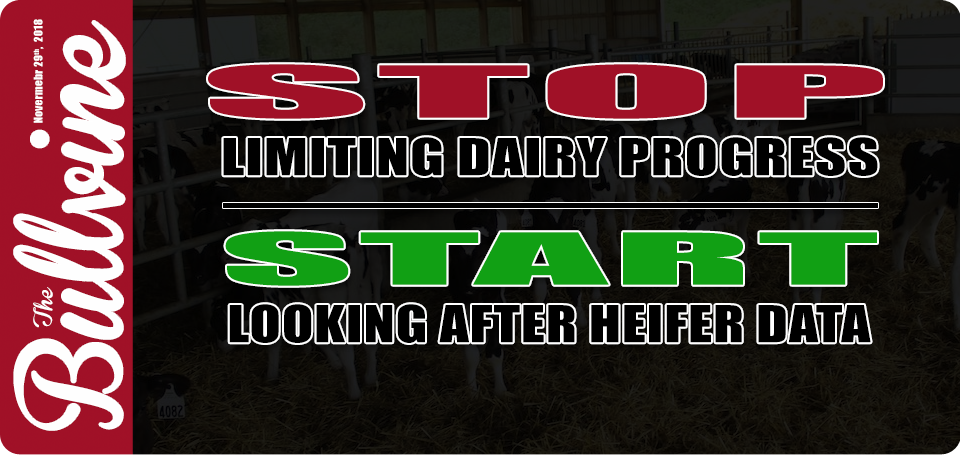How often have you heard that the post-weaning heifers are the most ignored, yes even neglected, animals on a dairy farm? From birth and until weaning, calves are fed and observed two or more times per day by humans and now increasingly by specialized machines … so, there can be on-farm records maintained either in hard copy or electronically. However, no matter how extensive the on-farm heifer records, much of the health, growth, sexual maturity, mobility and vaccination records never make it to the central national database.
We have Created the Impasse
Somewhere back in time, the dairy farming industry decided that cows and their information was important but that heifers were not important. Of course, that is not the case on all farms, but as an industry, we have not monitored and analyzed the performance of pre-producing animals in the way it occurs in the swine and poultry industries and partially in the beef, sheep and fish industries.
Why? Perhaps there is not a right answer to that question. Likely it has something to do with milk production being over 90% of the revenue from dairy herds. However, the more important question is how much is the dairy cattle industry missing out on increased on-farm profits by not performance recording and genetic indexing for heifer traits?
Times are Changing. Why Aren’t We?
It used to be that 52% of births were females and on average 90+% of heifers survived to first calving. In the past, it took $500 to feed and $800 total to raise a heifer to calving and fresh heifers sold for $1,500 to $2,500. So, raising all heifers meant that concern about heifer rearing costs and age at first calving did not significantly affect a farm’s bottom line.
Those days are history.
Today, with sexed (female) semen, 90+% of births are heifers and, as well, 95+% of heifers get to their first calving. It now costs $2,000+ to rear a heifer to calve at 24 months of age, and fresh heifers sell from $800 to $2000 depending on demand, pedigree and genetic merit. Where it was once a profit centre, rearing all heifers is now a losing proposition.
However, the important consideration is what will the best future program be for producing and rearing heifers as herd replacements? Dairy producers can avail themselves to heifer software management programs but, without a central producer owned database system, there will not be publicly available research, development, benchmarking and genetic analysis for heifer traits.
Think of the Possibilities
What would you like to know about your calves and heifers in the future for management, nutrition and genetic purposes? Some, but by no means all, items could be:
- Temperature, rumination, respiration, …
- Growth, …
- Immunity (including colostrum transfer and vaccination effectiveness), …
- Feed intake, feed efficiency, visits for feeding, magnet effectiveness, …
- Mobility, gate, stance, hoof care, …
- First heat, stage of estrus cycle, pregnancy, …
- Data to support guaranteed food safety, …
Some of these may be possible now; others will require new technology or devices. Most likely we will only get the heifer details if the data is captured electronically. Of course, the additional data points will be added to what is already known for animals on pedigree, DNA profile, …etc.
What is Currently Available? Is it enough?
Calf and heifer software management systems and devices are currently available, but some are stand-alone or not linked to an on-farm system.
A.I. and private companies have seen the need for more facts on calves and heifers and are producing private proprietary indexes for sires on immunity, disease resistance, feed conversion efficiency, wellness and other non-traditional traits. However, those indexes are just scratching the surface on what needs to be known.
Do We Have the Will to Change?
Ideally, all facts and figures must be in one data system on a farm that can be transferred to the national dairy data system that already stores the milk cow data. Until we have this calf and heifer data stored in the national dairy databases, it will not be possible to know their effect on and relationship with performance, economics and genetics.
A supplementary thought could be that if we knew more facts about young bulls destined for A.I. would we be able to more accurately know if they should enter A.I. or not?
The need is there. Yet … 1) will dairymen see that need and capture and transmit the data? and 2) will data centres do the analysis and provide the services in the areas of farm management and genetic evaluation?
The Bullvine Bottom Line
The dairy improvement industry must move beyond thinking that dairy cattle monitoring and improvement is only about milk cows. Extensive data for all heifer traits and characteristics are needed from conception all the way to herd removal. The average female spends sixty months in a herd. Twenty months or 33% of an animal’s lifetime, is being ignored.
The extent of this untapped opportunity to take the dairy cattle industry forward in viability and sustainability is significant. Is extensive calf and heifer data needed in the central data system? The answer to that question is – YES!
Get original “Bullvine” content sent straight to your email inbox for free.

















